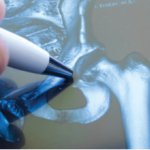“It’s frustrating for both the patient and physician to delay surgery, but we didn’t really know whether the data showed if the delay made a difference,” says Dr. Hannon. “So one purpose of the guideline was to determine the effectiveness of delaying surgery for additional nonoperative treatments in patients who elected to proceed with surgery using shared decision making with their physician.”
Guideline writers also wanted to explore the value of potentially delaying surgery to modify risk factors for poor outcomes, such as high BMI, poor glycemic control in diabetes and nicotine use.
The current guideline recommendations apply specifically to patients with radiographically verified moderate to severe osteoarthritis of the hip or knee or, less commonly, with advanced symptomatic osteonecrosis (e.g., secondary to inflammatory arthritis). These patients have moderate to severe pain or loss of function and have previously attempted a form of nonoperative treatment.1

Dr. Goodman
Dr. Goodman adds, “All these patients have tried at least one modality [such as physical therapy, NSAIDs or intraarticular injections] and have either failed to benefit or have lost benefit from these other nonsurgical interventions.” Clinicians have assessed these patients’ comorbidities and prior nonoperative treatments, and they are indicated for total joint arthroplasty.
Thus, this guideline on surgical timing complements existing the 2019 ACR guideline on osteoarthritis that focuses on management strategies for osteoarthritis of the hand, knee or hip of varying severity, which may include such modalities as weight loss, physical therapy and NSAID use.2
After a systematic literature review and a rating of evidence quality, a Voting Panel discussed the evidence for PICO questions (i.e., population, intervention, comparator, outcomes questions) and voted for or against specific recommendations. The panel achieved high consensus for most of the recommendations, all of which members categorized as conditional, partly due to the relatively low quality of evidence available for this specific population. For the additional context and extended discussion of the full recommendations, see the full guideline.
“This guideline should serve as a starting point for discussions between patients and physicians, so that the patient can participate in a shared decision-making process,” says Dr. Goodman.
Third-party payers often dictate whether patients are approved for arthroplasty, even when patients with severe disease have tried multiple nonoperative therapies without an acceptable improvement in pain, function & quality of life.
Delaying for Additional Interventions
Conditional recommendations: Proceed to arthroplasty instead of delaying arthroplasty three months. Proceed to arthroplasty over delaying arthroplasty for a trial of physical therapy, braces or ambulatory aids, NSAIDs, intra-articular glucocorticoid injections or viscosupplementation injections.

